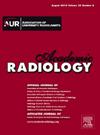Decision Fusion Model for Predicting Microvascular Invasion in Hepatocellular Carcinoma Based on Multi-MR Habitat Imaging and Machine-Learning Classifiers
IF 3.8
2区 医学
Q1 RADIOLOGY, NUCLEAR MEDICINE & MEDICAL IMAGING
引用次数: 0
Abstract
Rationale and Objectives
Accurate prediction of microvascular invasion (MVI) in hepatocellular carcinoma (HCC) is crucial for guiding treatment. This study evaluates and compares the performance of clinicoradiologic, traditional radiomics, deep-learning radiomics, feature fusion, and decision fusion models based on multi-region MR habitat imaging using six machine-learning classifiers.
Materials and Methods
We retrospectively included 300 HCC patients. The intratumoral and peritumoral regions were segmented into distinct habitats, from which radiomics and deep-learning features were extracted using arterial phase MR images. To reduce feature dimensionality, we applied intra-class correlation coefficient (ICC) analysis, Pearson correlation coefficient (PCC) filtering, and recursive feature elimination (RFE). Based on the selected optimal features, prediction models were constructed using decision tree (DT), K-nearest neighbors (KNN), logistic regression (LR), random forest (RF), support vector machine (SVM), and XGBoost (XGB) classifiers. Additionally, fusion models were developed utilizing both feature fusion and decision fusion strategies. The performance of these models was validated using the area under the receiver operating characteristic curve (ROC AUC), calibration curves, and decision curve analysis.
Results
The decision fusion model (VOI-Peri10–1) using LR and integrating clinicoradiologic, radiomics, and deep-learning features achieved the highest AUC of 0.808 (95% confidence interval [CI]: 0.807–0.912) in the test cohort, with good calibration (Hosmer–Lemeshow test, P > 0.050) and clinical net benefit.
Conclusion
The LR-based decision fusion model integrating clinicoradiologic, radiomics, and deep-learning features shows promise for preoperative prediction of MVI in HCC, aiding in patient outcome predictions and personalized treatment planning.
基于多核磁共振栖息地成像和机器学习分类器的预测肝细胞癌微血管侵犯的决策融合模型
理由和目标:准确预测肝细胞癌(HCC)的微血管侵犯(MVI)对于指导治疗至关重要。本研究评估并比较了临床放射学、传统放射组学、深度学习放射组学、特征融合和决策融合模型的性能,这些模型基于使用六种机器学习分类器的多区域 MR 生境成像:我们回顾性地纳入了 300 例 HCC 患者。瘤内和瘤周区域被分割成不同的生境,利用动脉相位磁共振图像从中提取放射组学和深度学习特征。为了降低特征维度,我们应用了类内相关系数(ICC)分析、皮尔逊相关系数(PCC)过滤和递归特征消除(RFE)。根据所选的最佳特征,使用决策树(DT)、K-近邻(KNN)、逻辑回归(LR)、随机森林(RF)、支持向量机(SVM)和 XGBoost(XGB)分类器构建了预测模型。此外,还利用特征融合和决策融合策略开发了融合模型。利用接收器工作特征曲线下面积(ROC AUC)、校准曲线和决策曲线分析对这些模型的性能进行了验证:结果:在测试队列中,使用 LR 并整合临床放射学、放射组学和深度学习特征的决策融合模型(VOI-Peri10-1)的 AUC 最高,达到 0.808(95% 置信区间 [CI]:0.807-0.912),具有良好的校准性(Hosmer-Lemeshow 检验,P > 0.050)和临床净效益:基于 LR 的决策融合模型整合了临床放射学、放射组学和深度学习特征,有望用于 HCC MVI 的术前预测,有助于患者预后预测和个性化治疗规划。
本文章由计算机程序翻译,如有差异,请以英文原文为准。
求助全文
约1分钟内获得全文
求助全文
来源期刊

Academic Radiology
医学-核医学
CiteScore
7.60
自引率
10.40%
发文量
432
审稿时长
18 days
期刊介绍:
Academic Radiology publishes original reports of clinical and laboratory investigations in diagnostic imaging, the diagnostic use of radioactive isotopes, computed tomography, positron emission tomography, magnetic resonance imaging, ultrasound, digital subtraction angiography, image-guided interventions and related techniques. It also includes brief technical reports describing original observations, techniques, and instrumental developments; state-of-the-art reports on clinical issues, new technology and other topics of current medical importance; meta-analyses; scientific studies and opinions on radiologic education; and letters to the Editor.
 求助内容:
求助内容: 应助结果提醒方式:
应助结果提醒方式:


